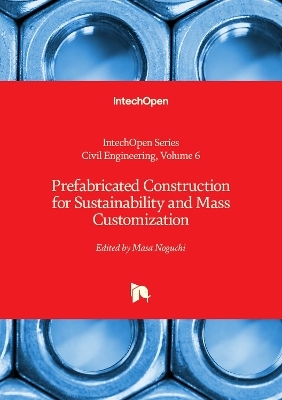
Prefabricated Construction for Sustainability and Mass Customization
Seiten
2024
IntechOpen (Verlag)
978-1-83769-252-1 (ISBN)
IntechOpen (Verlag)
978-1-83769-252-1 (ISBN)
An attempt to integrate sustainability and mass customization by reviewing the potential capacities of prefabricated construction. Nearly 40% of global energy use derives from construction. In fact, a house consumes a significant amount of energy before and after occupancy, and the associated CO2 emissions are contributing to climate change.
Building is a system of energy and environment, which needs to accommodate diverse needs and demands at individual and societal levels. Nearly 40% of global energy use derives from construction. In fact, a house consumes a significant amount of energy before and after occupancy, and the associated CO2 emissions are contributing to climate change. Prefabrication is a means to mass-produce buildings or parts and components. Thus, in theory, production costs can be reduced through economies of scale. In the 1920s, the significance of mass-produced houses was widely propagated by Le Corbusier who saw standardization as fundamental to mass production. Nonetheless, today, in response to growing global warming issues and the constant increase in energy prices, the construction industry is becoming more responsive to the delivery of sustainable architecture than ever. Within this context, sustainability may embrace not only building economy but also the adequacy beyond the legitimacy in which the quality barely coincides with individuals’ various dynamic needs, desires, and expectations today. In this respect, mass-produced prefabs alone fail to realize total sustainability. In 1987, a paradoxical concept of mass customization was introduced by Stanley Davis. Nonetheless, the idea applied to housing dates back to the 1950s. The essence of mass customizable architecture was speculated by Walter Gropius, as he emphasized the need for standardizing and mass-producing not only entire buildings but also their components. The combination of standard building components, which can be prefabricated, results in mass producing various types of constructions through economies of scope, where the quality can be defined by user choices of the components given in consideration of economic constraints and needs and demands. This book is an initial attempt to integrate the two notions of sustainability and mass customization by reviewing the potential capacities of prefabricated construction.
Building is a system of energy and environment, which needs to accommodate diverse needs and demands at individual and societal levels. Nearly 40% of global energy use derives from construction. In fact, a house consumes a significant amount of energy before and after occupancy, and the associated CO2 emissions are contributing to climate change. Prefabrication is a means to mass-produce buildings or parts and components. Thus, in theory, production costs can be reduced through economies of scale. In the 1920s, the significance of mass-produced houses was widely propagated by Le Corbusier who saw standardization as fundamental to mass production. Nonetheless, today, in response to growing global warming issues and the constant increase in energy prices, the construction industry is becoming more responsive to the delivery of sustainable architecture than ever. Within this context, sustainability may embrace not only building economy but also the adequacy beyond the legitimacy in which the quality barely coincides with individuals’ various dynamic needs, desires, and expectations today. In this respect, mass-produced prefabs alone fail to realize total sustainability. In 1987, a paradoxical concept of mass customization was introduced by Stanley Davis. Nonetheless, the idea applied to housing dates back to the 1950s. The essence of mass customizable architecture was speculated by Walter Gropius, as he emphasized the need for standardizing and mass-producing not only entire buildings but also their components. The combination of standard building components, which can be prefabricated, results in mass producing various types of constructions through economies of scope, where the quality can be defined by user choices of the components given in consideration of economic constraints and needs and demands. This book is an initial attempt to integrate the two notions of sustainability and mass customization by reviewing the potential capacities of prefabricated construction.
| Erscheinungsdatum | 01.06.2024 |
|---|---|
| Reihe/Serie | Civil Engineering |
| Verlagsort | London |
| Sprache | englisch |
| Maße | 178 x 254 mm |
| Themenwelt | Technik ► Bauwesen |
| ISBN-10 | 1-83769-252-1 / 1837692521 |
| ISBN-13 | 978-1-83769-252-1 / 9781837692521 |
| Zustand | Neuware |
| Haben Sie eine Frage zum Produkt? |
Mehr entdecken
aus dem Bereich
aus dem Bereich
Grundlagen und Vorgehensweisen
Buch | Softcover (2021)
Springer Fachmedien Wiesbaden GmbH (Verlag)
37,99 €
Bemessung von Stahlbauten nach Eurocode mit zahlreichen Beispielen
Buch | Hardcover (2024)
Springer Vieweg (Verlag)
59,99 €
Buch | Softcover (2024)
Springer Vieweg (Verlag)
18,99 €


